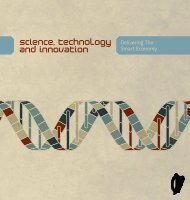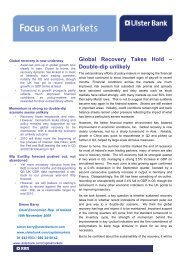RURAL IRELAND 2025 Foresight Perspectives - Coford
RURAL IRELAND 2025 Foresight Perspectives - Coford
RURAL IRELAND 2025 Foresight Perspectives - Coford
- No tags were found...
Create successful ePaper yourself
Turn your PDF publications into a flip-book with our unique Google optimized e-Paper software.
Rural Ireland <strong>2025</strong> - Synthesis Reportsuccessfully penetrate monitoring andsurveillance product and services markets.The three critical requirements for the positivescenario outlined above are:(i)(ii)A strong proactive and leadership role by theState in putting the sustainable development ofthe country’s marine resource centrally on theeconomic development and political agenda.Raising the intensity of research, technologicaldevelopment and innovation (RTDI), through afocused Marine RTDI Funding Programme, todevelop the necessary scientific understanding,technologies and innovative business modelsthat can realise efficiencies and create newmarine resource development opportunities forboth local and global markets.(iii) Raising environmental issues and concerns to apre-eminent position, maintaining a high qualityenvironment, balancing longer-termenvironmental impacts against short-termeconomic gains, and introducing into economicdevelopment models assessments of themonetary value of public goods and services.4.4 Rural landscapesContinued infrastructural developments andgeographical concentration of intensive agricultureand forestry (Sections 3.2 and 3.3), combined withthe potential impacts of climate change are crucialchallenges for the future management of rurallandscapes. Demands on rural space, includingpressures on water and other environmentalresources, will become more acute, especially in theeastern region, due to the combined effects of furtherpopulation growth and climate change (see ThematicPaper No.6).EU Directives, provided they are fully andproperly implemented in a timely manner, provide abasis for cautious optimism that the environmentaldegradation of recent decades will be arrested.However, as previously indicated, sustained financialand experienced human resources need to becommitted to conflict resolution in relation to thelocation of roads, utilities and other infrastructure, aswell as public access to rural landscapes. Otherwisethese issues could become substantial impediments tocontinued economic growth.The daunting challenge involved in striking theoptimum balance between economic developmentsand environmental management, points to theconcept of envisaging the environment as a virtualeconomic entity, within which a dynamic range ofcompeting developmental, environmental and socialpressures have to be systematically accommodated,without the demands of one sector impacting undulyon others.Inherent to this concept is the need repeatedlyreferred to, for the value of public goods, especiallythose provided by agriculture, forestry and the marinesectors to be quantified and priced, for their full valueto society to be included adequately in the process ofpolicy formulation. In this regard the establishmentof a strong national capability in environmentaleconomics is an urgent priority in building Ireland’senvironmental research capability.The complex array of interactive issues involvedin reconciling the seemingly conflicting demands ofenvironmental development and environmentalmanagement, need to be better understood, in order tobe managed effectively. This will require thesustained commitment of resources to a nationallymanaged environmental research programme. In thisregard, there is need to build on the researchprogrammes being financed and managed by theEnvironmental Protection Agency. In particular,closer integration of scientific and policy-orientedresources is essential in generating the knowledgerequired by policy and decision makers in devisingsolutions to emerging problems. Further to this, themajor structural changes expected in agriculture, inconjunction with climate change, underline thepressing need to establish cost effective baselinesagainst which the impacts of those and other majorchanges, on both the natural and culturalenvironment, can be objectively assessed and timelycorrective action taken where necessary.To ensure the environmental management ofintensively farmed regions (Section 3.2), urgentattention also needs to be given to the development ofa Public Goods Incentive Scheme, designed toencourage full-time commercial farmers to conservenatural habitats and archaeological sites, whilst notunduly inhibiting the profitability of their farmbusinesses.Unlike REPS, the proposed Public GoodsIncentive Scheme would not have predeterminedlimitations on the productivity of the entire farm. Thefocus of the scheme would be those part(s) of thefarm that have significant public goods, especiallynatural habitats, archaeological sites and historic18








